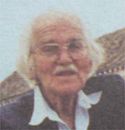Alfred Pal facts for kids
Quick facts for kids
Alfred Pal
|
|
|---|---|
 |
|
| Born | 30 November 1920 |
| Died | 30 June 2010 (aged 89) |
| Occupation | Painter, graphic designer |
| Spouse(s) | Branislava Žuvela (1962–2010) |
Alfred Pal (born November 30, 1920 – died June 30, 2010) was a famous Croatian painter and graphic designer. He lived through many big changes in history, including World War II, and used his art to express himself.
Contents
Early Life and School
Alfred Pal was born in Vienna, Austria, on November 30, 1920. His family was Jewish. His father, Stefan, owned a small factory that made shoe polish. His mother, Therese, was an actress in silent films.
In 1921, after World War I, Alfred's family moved to Poland. His father started a new factory there. Alfred had an older brother named Aleksandar. In 1923, his mother moved to Berlin, but she often visited her sons. A kind governess named Margareta Petruschke helped take care of Alfred and his brother.
Alfred started elementary school in Krakow, Poland, in 1926. When his father's business faced problems, they moved back to Vienna in 1929. Alfred and Aleksandar continued their schooling there. Sadly, their father died in 1931 while traveling. After this, Alfred and his brother moved to Vukovar, Croatia, to live with their aunt Judita and other family members.
In 1932, Alfred started high school in Vukovar. He was very talented at drawing. He even earned money during the summers by drawing funny pictures (caricatures) for people on the Adriatic beaches. He also taught German and math to help pay for his school.
His mother, who had been acting in Berlin, had to leave Austria in 1938 because of unfair treatment against Jewish people. In 1940, she finally managed to come to Yugoslavia and see her sons after 13 years! Alfred finished high school in 1940 and planned to study architecture.
World War II and Later Life
In 1941, when Yugoslavia was invaded during World War II, Alfred, his brother, and their aunt Judita had to hide. Life became very dangerous for Jewish people. Many were taken to special camps. Alfred's mother was arrested and sadly died in a camp in 1942.
In the summer of 1942, Alfred and his brother decided to try and escape the danger. His brother swam across the Danube river to Hungary, and Alfred never saw him again. Alfred managed to get to Crikvenica, which was controlled by the Italians at the time. He drew caricatures to earn money.
However, in November 1942, Alfred was arrested and sent to a detention camp. Later, he was moved to the Rab concentration camp. When Italy surrendered in 1943, the camp was freed. Alfred then joined the Yugoslav Partisans, who were fighting against the occupation. He even worked for their newspaper, Vjesnik.
After the war ended in 1945, Alfred returned to Vukovar. He found out that almost all of his family had been killed during the war, except for one cousin. This was a very sad time for him.
Alfred moved to Zagreb and started working for a weekly newspaper. He also helped start a funny newspaper called Kerempuh. He was its editor for a few years.
In the late 1940s, Alfred faced more difficulties. He was arrested and sent to Goli Otok, a prison for political prisoners, because of some political disagreements. He was there from 1949 to 1950, and again from 1951 to 1954.
After he was released, Alfred returned to Zagreb. He worked for different publishers, translating books and designing graphics. Even though he faced challenges, he kept working hard. He was an art editor at a publishing house called Matica hrvatska for many years. Later, he became an independent artist. Alfred was also a key person in starting Zgraf, a big exhibition for graphic design in Zagreb.
His Art and Design Work
Alfred Pal was a true master of graphic design, especially for books. He designed many books throughout his long career. He also created many posters for places like the Croatian National Theatre in Zagreb and the Modern Gallery, Zagreb.
As a painter, Alfred had twelve solo exhibitions in different cities like Zagreb, Vukovar, and Dubrovnik. His paintings were often abstract, meaning they didn't show real-life things exactly, but used shapes and colors to express feelings. He also used a special painting method called encaustic technique, which uses heated wax.
Awards and Recognition
In 2010, Alfred Pal received two very important awards for his life's work. He got the Vladimir Nazor Award for his achievements in fine and applied arts. He also received the city of Zagreb award for his lifetime contributions.
Personal Life
Alfred Pal married Branislava Žuvela in 1962. They had two children: a daughter named Aleksandra (named after his lost brother) and a son named Petar Samuel (named after his grandfathers). Alfred was a long-time member of the Jewish community in Zagreb. He passed away on June 30, 2010, in Zagreb and was buried at the Mirogoj Cemetery.
Images for kids


